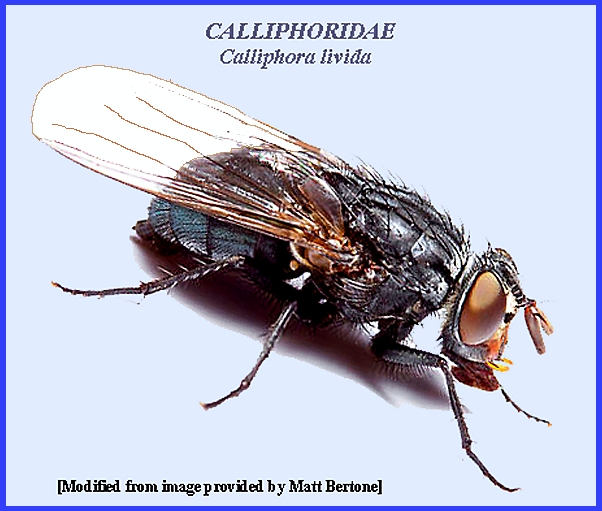File: <caliphoridaemed.htm> <Medical Index> <General Index> Site Description Glossary <Navigate
to Home>
|
Arthropoda: Diptera CALIPHORIDAE (Contact) Please
CLICK on
images & underlined links to view: Calliphoridae. -- <Habits>; <Adults> & <Juveniles> -- The blowflies,
bluebottle flies and screwworm
flies are flesh feeders. They lay
masses of eggs in dead animal carcasses.
The presence of these flies is indicative of a dead animal. Screwworm
flies are attracted to wounds and some species are parasitic and able to
penetrate living flesh. They are
especially prevalent in southeastern North America. Females lay their eggs in wounds and the larvae invade
surrounding tissue. They are especially
serious pests of sheep. Screwworms
were periodically effectively reduced in number by the liberation of males
that have been sterilized with radioactive cobalt. The females, which copulate just once, cannot produce progeny
if their mate is a sterilized male.
The flies were even completely eradicated from one island by the
deployment of this technique. Medication
of wounds on animals is effective in control, but it is necessary to be on
continuous alert for new wounds. Wool maggots are attracted to soggy
and wet wool, especially around the rump area. Precautionary control measures involve clipping the wool. The
maggots of some screwworm species are able to clean-up dead flesh from wounds
and thereby cause rapid healing, especially for very deep wounds. = = = = = = = = = = = =
= = = = = = = = Key References: <medvet.ref.htm> <Hexapoda> Bullington,
S. W. 2001. Blow flies: their life cycle & where to look for the
various stages. Forensic Entomology. Grimshaw,
P. H. 1901. "Part I.
Diptera". Fauna Hawaiiensis. 3 (1): 1–77 Grunin, K. Ya. 1966.
"New and little-known Calliphoridae (Diptera), mainly bloodsucking or subcutaneous
parasites of birds". Ent. Obozr (in Russian). 45: 897–903. Hall,
D. G. 1948. The blowflies of North
America. Thomas Say Publ. p. 4. Hardy,
G. H. 1940. "Notes on Australian
Muscoidea". Proc. Roy. Soc. Queensland 51: 133-146. Hastings,
Anne, D. Yeates & J. Hamilton.
2004. Anatomical Atlas of
Flies, CSIRO, Australia. Kurahshi,
Hiromu. 2007. 109, Family
Calliphoridae. Australasian/Oceanian Diptera
Catalog Matheson, R. 1950. Medical Entomology. Comstock Publ. Co, Inc. 610 p. Monaghan,
Peter. 2007. "Rx:Maggots, Notes
from Academe". The Chronicle of Higher Education. 53 (39): A48. Olsen,
Alan R. 1998. "Regulatory Action
Criteria for Filth and Other Extraneous Materials*1 III. Review of Flies and
Foodborne Enteric Disease".
Regulatory & Toxicology & Pharmacology 28 (3): 199–211 Peacock,
Andrew. 2004. Blow fly in Sheep. Newfoundland & Labrador Agriculture. Rognes,
Knut & T. Pape. 2007. Taxon
details: Calliphoridae. Fauna Europea version 1.1. Service, M. 2008.
Medical Entomology For Students.
Cambridge Univ. Press. 289 p Sherman,
R. 2006. Maggot Therapy Project. Maggot Therapy. Sutherst,
R. W., J. P. Spradbery & G. F. Maywald.
1989. "The potential geographical distribution of the Old World
screwworm fly, Chrysomya bezziana".
Med. Vet. Entomol. 3 (3): 273–280 Legner, E.
F.
1995. Biological
control of Diptera of medical and veterinary importance. J. Vector Ecology 20(1): 59-120. Legner,
E. F.. 2000. Biological control of aquatic
Diptera. p. 847-870. Contributions to a Manual of Palaearctic
Diptera, Vol. 1, Science Herald, Budapest. 978 p. Welch,
J. B. 1993. Predation by Spiders on Ground-Released Screwworm
Flies, Cochliomyia hominivorax (Diptera; Calliphoridae) in Mountainous Area of Southern
Mexico. J. Archnology 21(1): 23-28. Whitworth,
Terry. 2006. Keys to the Genera & Species of blow
flies (Diptera: Calliphoridae) of America North of Mexico. Proc. Ent. Soc. Wash. 108(3): 689-725 |
FURTHER DETAIL =
<Entomology>, <Insect Morphology>, <Identification Keys>



